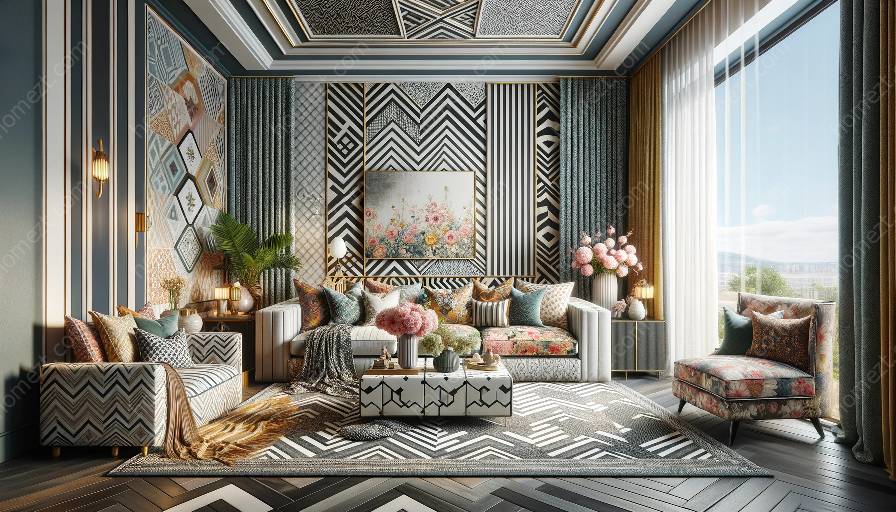Pattern mixing in open-plan living spaces provides both the challenge and opportunity to create a visually appealing and harmonious decor. By effectively applying pattern mixing, you can infuse a sense of personality and vibrancy into the space while maintaining a cohesive and balanced aesthetic. This article explores various ways to integrate patterns and offers decorating tips tailored to open-plan living spaces.
Understanding Pattern Mixing
Before delving into the application of pattern mixing, it's essential to understand the concept. Pattern mixing involves combining different patterns, such as stripes, florals, geometric designs, and plaids, within a space to add visual interest and depth. When executed thoughtfully, pattern mixing can elevate the design, imparting character and energy.
Guidelines for Effective Pattern Mixing
To create a captivating and balanced decor with pattern mixing in open-plan living spaces, consider the following guidelines:
- Scale and Proportion: Ensure that the patterns vary in scale and proportion to avoid overwhelming the space. Mix large-scale patterns with smaller ones to maintain visual balance.
- Color Palette: Coordinate the color palette of the patterns to create a cohesive look. Select a dominant color to tie the patterns together and introduce complementary or contrasting hues for dimension.
- Texture and Material: Incorporating a mix of textures and materials can enhance the visual appeal of pattern mixing. Consider combining smooth fabrics with textured ones to add depth and tactile interest.
- Consistency: Maintain a consistent design style or theme across the patterns to ensure a unified and harmonious decor. Choose patterns that share a common aesthetic or theme.
Application of Pattern Mixing in Open-Plan Living Spaces
Now, let's explore specific ways to effectively apply pattern mixing in open-plan living spaces:
1. Statement Upholstery
Utilize patterned upholstery for key furniture pieces, such as sofas or armchairs, to serve as the focal point of the living space. Pair bold, statement patterns with more subtle or neutral elements to create a striking yet balanced composition. Consider incorporating accent pillows in complementary patterns to enhance visual interest.
2. Layered Textiles
Introduce pattern mixing through various textiles, such as rugs, curtains, and throws. Layering different patterns can add depth and dimension to the space while creating visual intrigue. To achieve a cohesive look, ensure that the patterns complement each other and contribute to the overall aesthetic.
3. Accent Wall or Wallpaper
Consider incorporating patterned wallpaper or creating an accent wall with a bold, eye-catching pattern. This approach can instantly inject personality and visual appeal into the open-plan living space. Select a pattern that resonates with the overall design concept and opt for complementary decor elements to maintain a harmonious ambiance.
4. Mix of Geometric and Organic Patterns
Combining geometric patterns with organic, nature-inspired motifs can create an engaging visual dynamic. For instance, pair geometric throw pillows with floral or botanical prints to infuse a sense of balance and contrast into the decor. This juxtaposition adds depth and visual complexity to the space.
Decorating Tips for Pattern Mixing
When incorporating pattern mixing into open-plan living spaces, consider the following decorating tips to ensure a cohesive and attractive decor:
- Anchor with Solid Elements: Use solid-colored furniture or decor items to anchor the space and provide a visual break from the patterns. This helps prevent the decor from feeling overwhelming.
- Layering and Mixing Scales: Experiment with layering patterns of different scales to create visual interest. Mix large-scale patterns with smaller ones to achieve a visually appealing composition.
- Unified Color Scheme: Establish a unified color scheme that ties the patterns together. Select a dominant color as a unifying element and incorporate it across various patterns.
- Consider Negative Space: Allow for negative space within the decor to prevent overcrowding. Embrace the balance between patterned and unadorned areas to maintain a sense of openness and airiness.
Conclusion
Pattern mixing in open-plan living spaces offers a captivating opportunity to curate a visually stimulating and harmonious decor. By understanding the principles of pattern mixing and applying thoughtful guidelines, you can transform your living space into an inviting and dynamic environment. Embrace the interplay of different patterns and unleash your creativity while adhering to a cohesive design vision.






































